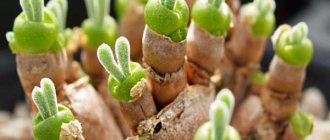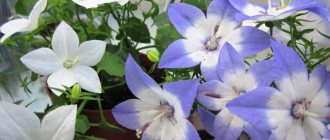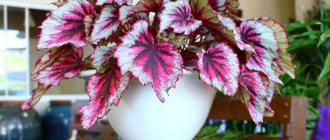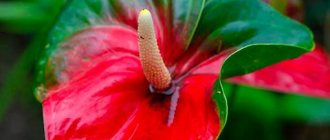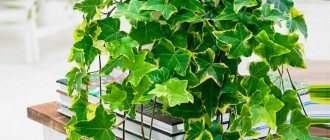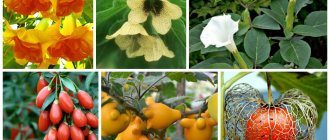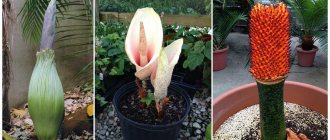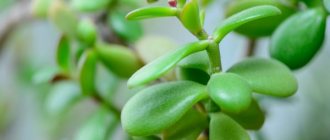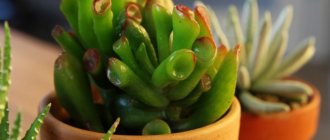Types and varieties of Crassula
The silver crassula has gained fame as the money tree, although sometimes the tree-like crassula is also called that. However, the world of Crassula is so large that collectors of succulent plants create entire indoor gardens from these plants. Many rare species can be found in flower shops in pots called mix (1).
Crassula oval, or ovoid (Crassula ovata). A fairly large, fast-growing plant up to 150 m in height with oval glossy leaves of green or gray-silver color. Small white or pink flowers are collected in apical umbels. Unlike other species, it is shade-tolerant.
This species has several interesting varieties.
- Blue berd is a small tree with curly bluish-blue leaves that sit tightly on the trunk; this variety is often sold as Crassula arborescens;
- Crosby's Compact - has a compact shape, small pale red leaves, used in indoor mini-gardens.
- Sunset is a spectacular variety with tricolor leaves: stripes of yellow and white and a red border on a green background.
- Hobbit is a very original variety with everted or fused leaves, bred by American breeders in the late 70s of the last century.
Variety Crosbys compact. Photo: pixabay.com
Variety Crosbys compact. Photo: pixabay.com
Hobbit variety. Photo: pixabay.com
arborescens . Outwardly, it is similar to Crassula ovoid: a powerful trunk and bare branches, fleshy, flat, rounded grayish leaves with a pale blue tint and a red border. The flowers are white or pink, but it blooms extremely rarely indoors. Loves bright sun (1).
Presented not by varieties, but by forms:
- undulatifolia - with flat narrow leaves of silver-blue color and characteristic red tips;
- undulatifolia variegata - with a white stripe along the edge of the leaf;
- curly (curviflora) - has a pronounced wavy edge on the leaves.
Crassula arborescens undulatifolia.
Photo: pexels.com Silver Crassula, or purslane (Crassula portulacea). This is one of the types of money tree. Very similar to Crassula tree-like and oval. But this plant is more compact, in cultivation it reaches 1 m. The trunk is almost even, narrowing only at the top. The leaves are oval, placed in pairs opposite, but each pair is located perpendicular to the previous one. It blooms rarely, with light pink, odorless flowers in racemes.
Crassula Buddha's Temple. The dream of many gardeners. This is an unusual type of Crassula - the result of crossing Crassula pervoliata and pyramidal. It was created in 1959 by the American breeder Myron Kimnah, an amazing gardener who had no special education (2).
Crassula Buddha's Temple. Photo: YouTube
The plant has the appearance of a column; tightly pressed triangular leaves of dark green color are strung on the stem. The apical inflorescences consist of red flowers. As soon as the Crassula reaches a height of 15 cm, the stem falls on its side. Therefore, the plant is grown in compositions with stones that can support it.
It may be sold under the names Kimnachi or Myron Kimnach.
What plants are similar to Crassula perforatum?
- Aichryson tortuosum . Low shrub. The leaves are diamond-shaped, fleshy, green.
- Aichryson x domesticum . A hybrid variety, forms a compact bush up to 25–30 cm high. The leaves are fleshy and small.
- Wall Monanthes (Monanthes muralis) . Dwarf bush, up to 10 cm in height. Succulent, blunt-pointed leaves are arranged alternately.
- Monanthes amydros . The evergreen succulent has rounded or pointed fleshy leaves. Inflorescences are racemose.
- Graptopetalum paraguayense . The stem is short and succulent. The fleshy leaves are pointed and covered with a bluish waxy coating.
Crassula perforatum is popular not only because of its original appearance, it is also a very useful flower. It secretes substances with antiviral and antibacterial properties; the juice of the leaves is often used in folk medicine.
Caring for crassula flowers at home
The types of Crassula are so diverse that many gardeners do not stop at one plant, but collect a whole collection. It is not difficult to maintain because the plants are unpretentious. The main task is not to fill it with water!
But not everyone succeeds in achieving flowering. This requires time, care, summer at the dacha and cool keeping in winter - from 10 to 15°C.
Priming
Soil for Crassula can be bought ready-made, marked “for succulents”. Or prepare it yourself, remembering that it should be light, well-drained, permeable to air, neutral or slightly acidic (within 5.5 - 6.5 pH). The soil for Crassula consists of turf soil, leaf humus, mature compost and coarse sand or perlite (1: 3: 1: 1). The second option is used for ground cover and miniature species of Crassula - turf soil, leaf humus and coarse sand (2:2:1).
Lighting
Most types of Crassula prefer a high degree of illumination, but it is better to place them on windowsills facing east or southwest. In the summer, the pots can be moved to the loggia or garden. To avoid sunburn, plants should be protected during midday hours with a light net.
“To ensure that plants develop evenly, regularly turn the pot towards the light source,” advises plant collector Elizaveta Starostina.
Humidity
Crassulas are drought-resistant due to the fact that they accumulate moisture in the fleshy stems and leaves. In summer, plants are watered after the top layer of soil dries, in winter - until the soil dries to a depth of 2 - 3 cm. In practice, this means that in summer Crassulas are watered once every 2 weeks, and in winter once a month. Overwatering is detrimental to the plant - the roots begin to rot. But prolonged drought also leads to wrinkling and falling of leaves.
These plants do not need spraying or high humidity, but they respond very well to washing the leaves with clean water using a cotton pad.
Fertilizers
When planting Crassula in the soil, you need to add fertilizer for succulents, but use half the dose recommended by the manufacturer. They also need wood ash (no more than 1 teaspoon per pot).
Feeding
In the spring-summer period, Crassulas need feeding: once every 3-4 weeks, the plants are watered with a fertilizer solution for succulents or cacti. From September, feeding is stopped. However, if the plants are kept warm, it is recommended to feed them once every 40 days.
Flower growers often use water-soluble, slow-release fertilizer in the form of sticks.
Trimming
Some types of Crassula require formative pruning. The shape of the tree begins to be created in a young plant so that the trunk turns out smooth and beautiful. As soon as the young plant reaches a height of 15 cm, two leaves are plucked out at the top - two new shoots will begin to grow in their place. Next, you will need to regularly remove leaves in those places where you want to get branching.
Species with climbing or rosette leaves also need pruning. But this, as a rule, happens only after flowering, when the part of the rosette where the flowers were begins to die.
Characteristic
Crassula minor is an artificially bred variety that is a variety of Crassula ovata. The leaves of the plant are quite small - no more than 1.5 centimeters in length and 1 centimeter in width. They have an oblong shape. The coloring is very interesting, which allows it to complement any garden compositions with Crassula - the edges of the leaf above and below are framed in red, and the middle of the leaf is dark green. Depending on the lighting, the indoor plant changes its shade.
The trunk of young Crassula minor is green, fleshy and soft. Over time, when the lower leaves die, it becomes bare and woody. This property of the plant allows it to form miniature trees as it grows.
Reproduction of Crassula at home
Crassulas reproduce by seeds and cuttings.
Seeds. Seeds are sown in wide bowls superficially on a substrate of sand and leaf soil (1:2). The bowl is covered with film or covered with glass, and placed in a bright and warm place. Condensation is removed and ventilated daily.
The first shoots appear after 15 - 20 days. Grown-up specimens are planted in separate small pots with a light substrate of turf and leaf soil and sand (1:2:1). Seedlings are grown at a temperature of 16 - 18 ° C in a bright place.
By cuttings. Propagating Crassula by cuttings is much easier and faster. Not only stem segments, but also leaves are suitable for rooting. The cut areas are dusted with crushed charcoal and dried for 2 - 3 days. Then they are planted in a light substrate of leaf soil and sand.
You can also root the cuttings in cups of water by adding half a tablet of activated carbon. After the roots appear, the cuttings are planted in small pots with a light substrate.
After 1 - 2 months, the rooted plants can be planted in permanent pots and cared for like adult plants.
Transplanting Crassula at home
The first transplant is done 14 - 30 days after purchase in order to replace the transport soil with nutritious soil. The pot is selected a little wider than the one in which you bought it.
Then transplants are done either urgently (if the plant is sick) or as the root system fills the pot. In some cases, a transplant is done once every 5 years. If the goal is to see Crassula bloom, then replanting must be done every two years.
It is important to choose the right pot. It should be wide, but not deep, since the root system of Crassula is superficial. For tall species, the pot should be heavy enough with a wide bottom to prevent it from tipping over under the weight of the crown.
A layer of drainage at least 2 cm thick must be laid at the bottom. Small pieces of red brick or a clay pot perform this role very well.
The soil must have good water and air permeability. Even in special soil for cacti and succulents, add 1 part of coarse sand or perlite. Transplantation is done using the transshipment method. If the root system has grown too wide, then it is slightly trimmed and the sections are dusted with crushed coal.
To obtain a compact crassula bush, replanting is done once every 5 years, into a pot that is no more than 3 cm wider in diameter. To improve nutrition, the top layer of soil is removed every year, replacing it with fertile soil.
Crassula diseases
Bacterial burn. Its main manifestation is red spots on the leaves.
Diseased leaves need to be removed, plants should be sprayed 2-3 times with Fitosporin-M (3) with an interval of 10 days.
Yellowness of leaves. It causes the leaves to gradually change color to yellow.
Treatment consists of removing the affected shoots.
Mosaic epiphyllum. It destroys plant tissues - transparent, blurry yellow spots appear on them.
Treatment is impossible, the plant is destroyed.
Fusarium. First it affects the roots, then penetrates the stems and leaves. Crassula stops growing, the leaves turn pale and become lethargic, and a rusty tint is visible on the cut.
Diseased areas are cut out, sprayed with Fitosporin-M solution (3), dried, and replanted in fresh soil.
Anthracnose (brown spot). Appears in the form of round light or brown spots on leaf plates.
At the initial stage, diseased parts of the plant are cut out, and the sections are sprinkled with charcoal. Then spray 2 - 3 times with a solution of Fitosporin-M (3) with an interval of 10 days.
Crassula flower: features of the genus of succulent culture
Crassula is a large genus of succulent plants found in many parts of the world, but the species used in horticulture or by collectors mostly originate in South Africa. The genus Crassula has an average of 300-500 species.
Photos of different types of Crassula
The external diversity of Crassulas is very great. Such succulents are found in the form of herbaceous or aquatic plants, they can be tree-like shrubs, miniature succulents. A common feature of most representatives of the genus is the placement of leaf blades on the shoot opposite each other. At home, Crassula are smaller in size than those that grow in nature. But over time, the crop becomes a miniature or medium-sized tree, which has a fairly thick stem.
The leaves have a simple, entire-edged shape; some species have ciliated leaf blades. Inflorescences can be lateral or terminal, the configuration is racemose or umbellate-paniculate. Flowers can consist of several shades - yellow, red, white, pale blue. But keep in mind the fact that indoor Crassula almost never blooms.
But their unpretentiousness, ease of care, and spectacular appearance have made these types of plants one of the most popular in decorating rooms.
Crassula pests
Mealybug. This pest settles in the axils of leaves and roots. And it looks like a white cotton-like coating.
First you need to rinse the plant under running warm water. Then use alcohol. But do not spray it, but treat the trunk and leaves with a cotton swab, moistening it in the solution. If it is possible to take the plants out onto the balcony or into the garden, then the infected Crassula should be sprayed with Actellik or Fufanon solution (3).
Spider mite. It populates Crassula in warm and dry rooms. Pests pierce the leaves and feed on the sap of the plant, inhibiting it.
The first thing to do is to thoroughly rinse the plant in the shower, first whipping the soap into foam and applying it to the trunk and leaves. For a day, the washed plants are placed in a large plastic bag to maintain high humidity. Then the plant is treated with Antiklesch, Apollo or Fitoverm (3).
Shield. The pest looks like dense tubercles.
This is a fairly large insect, so it is first removed from the plant by hand and destroyed. Then wipe the affected areas with a cotton pad moistened with alcohol. Double spraying with Actellik or Fitoverm (3) is effective.
